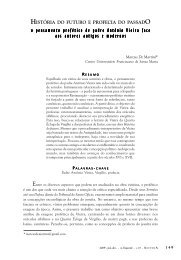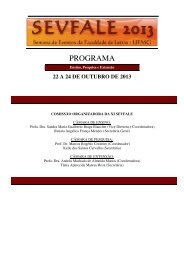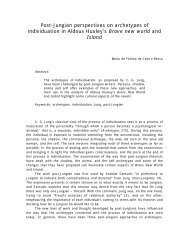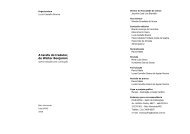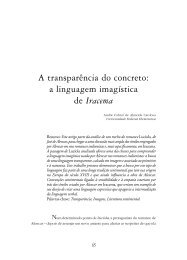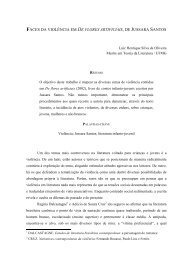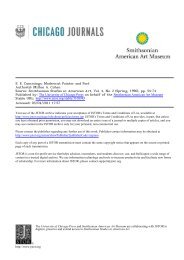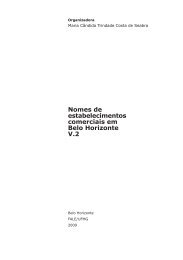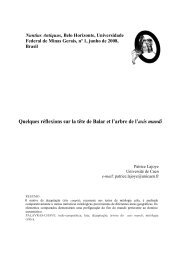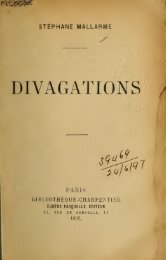Contornos do Indizível: o estilo de Clarice Lispector - Fale - UFMG
Contornos do Indizível: o estilo de Clarice Lispector - Fale - UFMG
Contornos do Indizível: o estilo de Clarice Lispector - Fale - UFMG
You also want an ePaper? Increase the reach of your titles
YUMPU automatically turns print PDFs into web optimized ePapers that Google loves.
Em Tese, Belo Horizonte, v. 10, p. 41-46, <strong>de</strong>z. 2006<br />
(“brimming”) that are all conciliated by the rea<strong>de</strong>r — the viewer, or the speaker of the<br />
poem. This theory about “text” and “the role of rea<strong>de</strong>rs” was first proposed by Roland<br />
Barthes, in the essays “From Work to Text” and “The Death of the Author”.<br />
The poet therefore moves from a mere observer of the painting to one that reads<br />
it, conciliating words and images. The tool for such conciliation is enunciated by the<br />
metapoetic consciousness in lines 24 and 25: “ekphrasis.” As an ancient form of<br />
literary genre, it takes place, basically, when a writer attempts to re-create, in the<br />
verbal system, a work originally composed in another semiotic system. In<strong>de</strong>ed, as the<br />
roots of the word ekphrasis show, in<strong>de</strong>ed, it was used to refer to direct verbal<br />
<strong>de</strong>scriptions of visual representations. In Latin, it means “<strong>de</strong>scription” and is related to<br />
a rhetorical exercise that aimed at <strong>de</strong>scribing an object (referent) in a way that it<br />
should seem “alive” before the eyes (Ekphrasis 64). At first, the objects used as<br />
mo<strong>de</strong>ls (2 A.D.) were people, places, and scenes of festivals. Only later (5 A.D.),<br />
ekphrasis turned out to be <strong>de</strong>scriptions of works of art.<br />
It was Homer, in the Iliad, who improved the ekphrastic exercise, incorporating it<br />
in his epic. The most famous ekphrastic passage in literature (Book 18 of the Iliad)<br />
consists of the <strong>de</strong>scription of the shield wrought by Hephaestus for Achilles. This is also<br />
the longest ekphrastic passage in Homer’s work — about 130 lines — containing some<br />
characteristics that reflect the world of the Iliad itself, besi<strong>de</strong>s pointing out some of the<br />
“possible” features of post-Homer ekphrasis.<br />
James Heffernan attempts to investigate ekphrasis and elucidate the permanent<br />
struggle between the “image” and the “word” — the paragonal relation between visual<br />
arts and literature. In his “Introduction,” he proposes a <strong>de</strong>finition for ekphrasis: “the<br />
verbal representation of a visual representation” (Heffernan 3). This <strong>de</strong>finition exclu<strong>de</strong>s<br />
a number of literary works that have been called ekphrasis. He argues that concrete<br />
poems may “remind” the viewer of graphic images, but <strong>do</strong> not aim at reproducing a<br />
particular visual work, and claims that ekphrasis is a verbal representation of visual<br />
works that are essentially representational. According to him, representational works<br />
are the ones that have aesthetic values above all. The critic, thereby, exclu<strong>de</strong>s poems<br />
about visual works, which have an immediate utilitarian function (Heffernan 193). He<br />
gives as an example of a non-representational work the Brooklyn Bridge, which was<br />
the source of inspiration for Hart Crane’s poem “The Bridge.” According to Heffernan,<br />
this poem is not ekphrastic because even though Crane <strong>de</strong>scribes the bridge using<br />
pictorial terms, it is still a bridge, not an aesthetic object.<br />
Although some scholars, such as W.J.T. Mitchell, a<strong>do</strong>pt Heffernan’s <strong>de</strong>finition,<br />
Claus Clüver disagrees in part. He revisits Heffernan’s explanation of ekphrasis, and<br />
<strong>de</strong>ci<strong>de</strong>s to modify it, claiming that the author <strong>do</strong>es not explain well or give clear<br />
reasons for restricting ekphrasis to representational works, believing that the<br />
insistence on the subjectivity of the term “representational” causes difficulties for<br />
criticism. While preserving the first part of Heffernan’s <strong>de</strong>finition (“Ekphrasis is a verbal<br />
representation”), he proposes a radical change for the second part. According to him,<br />
ekphrasis is “the verbal representation of a real or fictitious text composed in a nonverbal<br />
sign system” (26).<br />
The main difference in relation to Heffernan’s is the referent object of the<br />
ekphrasis. While Heffernan exclu<strong>de</strong>s objects that are not essentially representational,<br />
such as the Brooklyn Bridge, for instance, which was built for an immediate practical<br />
purpose, Clüver’s <strong>de</strong>finition “<strong>do</strong>es not restrict the objects of ekphrasis to<br />
representational texts: it covers architecture, as well as absolute music and nonnarrative<br />
dance” (26). In<strong>de</strong>ed, Clüver chooses not to classify the referent objects as<br />
Disponível em http://www.letras.ufmg.br/poslit<br />
43



